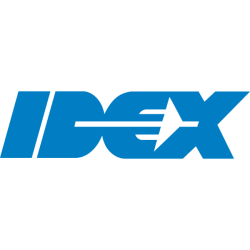Overall, IDEX Corporation demonstrates strong business quality through its competitive advantages and focus on innovation. However, market volatility and uncertainty present challenges. Future prospects appear positive with growth expectations and strategic capital deployment, although risks remain due to macroeconomic conditions.
Analysis Date: February 5, 2025
Last Updated: March 12, 2025
Trailing Twelve Months (TTM) values provide a view of the company's performance over the last year.
Graham Value Metrics
Benjamin Graham's value investing approach focuses on finding stocks with a significant margin of safety between their intrinsic value and market price.
Intrinsic Value
Estimated fair value based on Graham's formula
$174.97
Current Market Price: $161.94
IV/P Ratio: 1.08x (>1.0 indicates undervalued)
Margin of Safety
Gap between intrinsic value and market price
7.000000000000001%
Graham recommended a minimum of 20-30% margin of safety
Higher values indicate a greater potential discount to fair value
ROE: 13.569797124815263
ROA: 1.8264569403881221
Gross Profit Margin: 44.21194322075379
Net Profit Margin: 15.449094468918256
Trailing Twelve Months (TTM) values provide a view of the company's performance over the last year.
Strong Return on Equity
Return on equity at 13.57% reflects effective use of shareholders' equity to generate profits, indicating strong financial performance.
Healthy Net Profit Margin
A net profit margin of 15.45% indicates that the company retains a good portion of its revenue as profit, showcasing operational efficiency.
Moderate Operating Profit Margin
0.2091
Operating Profit Margin
The operating profit margin of 20.91% suggests that while the company is profitable, there may be room for improvement in controlling operating costs.
About Profitability Metrics
Profitability metrics measure a company's ability to generate earnings relative to its revenue, operating costs, and other relevant metrics. Higher values generally indicate better performance.
Return on Equity (ROE)
Measures how efficiently a company uses its equity to generate profits
13.57%
10%
15%
Higher values indicate better returns for shareholders
TTM (as of 2025-04-16)
Return on Assets (ROA)
Measures how efficiently a company uses its assets to generate profits
1.83%
3%
7%
Higher values indicate better asset utilization
TTM (as of 2025-04-16)
Gross Profit Margin
Percentage of revenue retained after accounting for cost of goods sold
44.21%
20%
40%
Higher values indicate better efficiency in production
TTM (as of 2025-04-16)
Net Profit Margin
Percentage of revenue retained after accounting for all expenses
15.45%
8%
15%
Higher values indicate better overall profitability
TTM (as of 2025-04-16)
Strong Liquidity Ratios
A current ratio of 2.53 and a quick ratio of 1.85 indicate that the company is well-positioned to cover its short-term liabilities, showing strong liquidity.
Low Debt Levels
0.5234
Debt-to-Equity Ratio
A debt-to-equity ratio of 0.52 indicates a moderate level of debt, suggesting financial stability and lower risk associated with borrowing.
Moderate Interest Coverage
15.3573
Interest Coverage Ratio
While an interest coverage ratio of 15.36 is solid, it indicates that while the company can cover its interest obligations, it is not excessively strong relative to very low-risk firms.
About Financial Health Metrics
Financial health metrics assess a company's ability to meet its financial obligations and its overall financial stability.
Debt to Equity Ratio
Total debt divided by total equity
0.52x
1.0x
2.0x
Lower values indicate less financial leverage and risk
Less than 1.0 is conservative, 1.0-2.0 is moderate, >2.0 indicates high risk
Q4 2024
Current Ratio
Current assets divided by current liabilities
2.53x
1.0x
2.0x
Higher values indicate better short-term liquidity
Less than 1.0 is concerning, 1.0-2.0 is adequate, greater than 2.0 is good
Q4 2024


